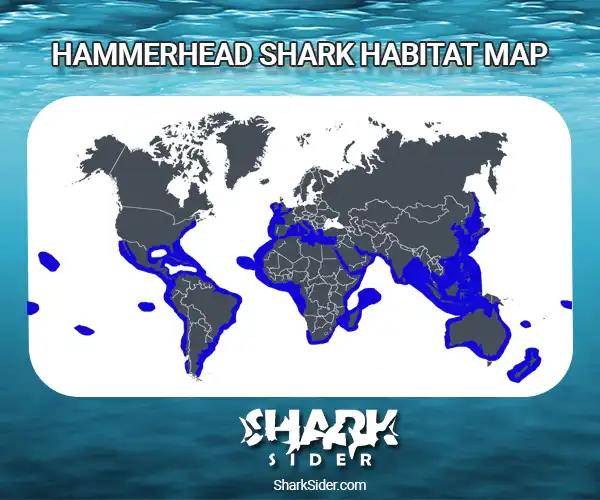Ah yes, the Hammerhead Shark. Take one look at this amazing fish and you’ll know how it got its name. The scientific name for its hammerhead-shaped head is called Cephalofil.
Found far offshore in warm tropical waters throughout the world, there is one shark that sets itself apart from other shark species in more ways than one—especially in appearances: The Hammerhead Shark. Due to their ability to survive in sandy plains, kelp forests, fresh as well as ocean waters, and intertidal waters, they get around quite easily, and you can catch a glimpse of them almost anywhere.

The Hammerhead Shark, also known as Sphyrnidae, is one of the most recognizable shark species out there due to its wide, flat, T-shaped head and wide-set eyes. They use their oddly-shaped heads to improve their ability to find prey; their wide-set eyes provide superior visual range to most other sharks, and they have highly specialized sensory organs spanning across their heads, enabling them to thoroughly scan the ocean for food.
Though they have a more mellow temperament than other sharks, the Hammerhead takes hunting for food very seriously and can locate prey more easily due to their heightened sense of smell. Their diet consists of small fish, squid, stingrays, crabs, and even other small sharks.
Why The Strange Head?
The Hammerhead’s head is a marvel of evolution. Its cephalofoil allows it to sense the electrical pulses emitted by prey, such as stingrays, their favorite meal. These sharks swim close to the ocean floor, moving their heads side to side like a metal detector to locate stingrays hidden in the sand.
Their unique skin, covered in dermal denticles, enhances their ability to detect scents. These ridged structures channel water toward their nares (nostrils), making them highly efficient hunters. With these adaptations, Hammerheads are perfectly designed to capture elusive prey.
Different Species of Hammerheads
- Winghead Shark: Known for its especially long and slender head lobes, this small species averages around 4 feet in length and is typically gray or light brown with a lighter underside.
- Bonnethead & Scalloped Bonnethead: These smaller species range from 2 to 5 feet long. Females are slightly larger than males. They are grayish-brown with dark spots and require continuous swimming to oxygenate their gills.
- Whitefin Hammerhead: Similar in appearance to the Scalloped Hammerhead, this species has a narrow-bladed head and averages 9 feet in length.
- Scalloped Hammerhead: Found in coastal regions, this species averages 13 feet in length and is typically olive, bronze, or light brown with a white belly.
- Great Hammerhead: The largest species, reaching up to 20 feet long. However, the average size is closer to 11 feet.
- Smalleye Hammerhead: This smaller species measures around 5 feet and has a broad, mallet-shaped head with a deep indentation at its center.
- Smooth Hammerhead: Distinguished by a single notch in the center of its head, it measures 8 to 11 feet and has black-tipped pectoral fins.
Hammerheads Lifespan
The lifespan of most Hammerheads is between 25 and 35 years, though there’s evidence that they may live longer. Their ability to make sharp, sudden turns is attributed to the unique design of their heads, which also aids in balance.
Interestingly, Hammerheads are among the few animals capable of tanning. Prolonged exposure to sunlight while cruising in shallow waters causes their skin to darken.
Habitat
Hammerhead Sharks thrive in tropical, warm waters worldwide. They are primarily found near continental shelves and coastlines but occasionally venture into the deep ocean, cruising near the surface.
Hammerhead Shark Habitat Map

Sensory System
Hammerheads rely on a specialized sensory organ called the ampullae of Lorenzini to detect electrical pulses emitted by living creatures. This allows them to sense prey, including the beating heart of a human, from miles away.
Hammerhead Shark Teeth
Hammerheads have smooth-edged teeth with a distinct notch on one side. These teeth are perfect for gripping and tearing prey. They range in size from 1/4 to 3/4 of an inch.
Social Life
While Great Hammerheads are solitary, Scalloped Hammerheads often form schools of over 100 individuals. These schools provide protection and mating opportunities. Such gatherings attract tourism, especially in areas like the Great Barrier Reef and the Galapagos Islands.
Hunting Behavior
Hammerheads are nocturnal hunters with a preference for bottom-dwelling prey like rays, shrimps, and squids. Their unique head shape allows them to “scan” the ocean floor for hidden prey.
Offspring
Hammerheads are viviparous, giving birth to 20 to 50 pups at a time. The reproductive process remains a subject of ongoing study.
Relationship with Humans
Many Hammerhead species face extinction due to overfishing and the demand for their fins, which are considered a delicacy. Despite their size, they pose minimal threat to humans, with only three species ever recorded in unprovoked attacks. Divers often find them fascinating and safe to observe.
Fascinating Facts About Hammerhead Sharks
- Hammerheads can tan from prolonged sun exposure in shallow waters.
- They are among the few shark species that form schools, sometimes with over 100 individuals.
- Their cephalofoil helps them make sharp, agile turns while hunting prey.
- They possess dermal denticles, reducing drag and enhancing swimming efficiency.


